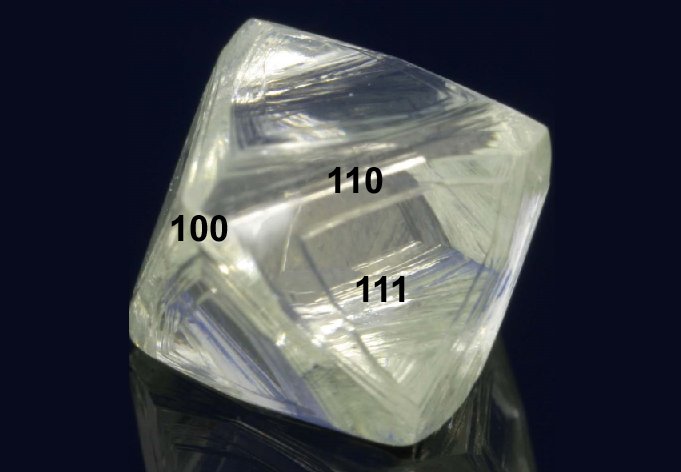
Re-Cutting Diamonds
The crystal structure of diamonds has a significant impact on what cut grade and more specific, the polished grade could be achieved. Diamond surfaces are anisotropic, meaning that they have varying degrees of hardness. Some areas (crystal faces) can be cut and polished and others not. Diamond polishers have to know where to cut facets so as to avoid having any facets coinciding with such faces.
The image of a rough diamond below is annotated to show the position of the three possible crystal faces (octahedral -111, dodecahedral -110 and hexahedral or cube faces-100) of a diamond. We are adding the Miller indices for convenience, hence the numbers.
There is a total of 6 cube faces (100), 8 octahedral faces (111) and 12 dodecahedral faces (110). The 111 faces are the hardest, in fact, they are near impossible to cut and polish. The next hardest is the 100 faces, followed by the 110 faces. This variance can be proven on the atomic level, which is outside of the scope of this article. Diamond polishers have to know the orientation of the crystal and avoid having facets coincide with the 111 and 100 faces. Working on a rough diamond is a piece of cake as the crystal orientation is clearly visible. This is however not the case with polished diamonds. If there are no naturals present on a diamond, it is very difficult to determine the crystal orientation i.e. knowing where the various crystal faces are. This could lead to problems for polishers when re-cutting a diamond. The matter is more complicated when the goal is to achieve triple excellent cut grades, and even more so when tight weight thresholds have to be preserved. This will not allow for slight re-orientation of the diamond.
Then there is the matter of graining and twinning. Twinning is when a part(s) of a diamond’s crystal orientation does not conform to the crystal orientation of the ‘main stone.’ Whenever twinning is present on a facet, the cutting direction of the facet could be diametrically opposite to the twinned portion to that of the main diamond. It is like asking a person in Oklahoma City to travel to New York and Los Angeles at the same time. Polishers have to alternate the polishing direction, which is a time-consuming exercise, often with a compromised surface finish. This causes the surface to be uneven and worst still to have drag lines coming off the twinning.
Re-cutting diamonds is, therefore, a highly specialized skill with complicated challenges as mentioned before. Some diamonds for reasons mentioned can never obtain triple excellent for polish. As far as symmetry and cut are concerned, there should be no reasons for not achieving excellent.
Jewellers can look out for possible challenging diamonds by inspecting them for signs of twinning. If there is a twinning line parallel to the girdle on the pavilion side, then it is not much of a problem. If it, however, runs oblique to the girdle, crossing into the crown or worst still more or less perpendicular to the girdle, then there is potentially a severe polishing problem.
Address :
- POPLEY
- Popley Avenue Premises CSL,125, Turner Road, Mumbai 400050, Maharashtra, India +91-22-66710000
- Ground Floor, Panchratna, Opera House, Mumbai – 400004, Maharashtra, India +91-22-66348856
- F31, Grand Hyatt Plaza, Grand Hyatt, Santacruz (E), Mumbai 400055, Maharashtra, India +91-22-30602000
Shop for deals online at https://www.garnerbears.com


